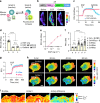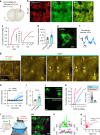Intensiometric biosensors visualize the activity of multiple small GTPases in vivo
- PMID: 30643148
- PMCID: PMC6331645
- DOI: 10.1038/s41467-018-08217-3
Intensiometric biosensors visualize the activity of multiple small GTPases in vivo
Abstract
Ras and Rho small GTPases are critical for numerous cellular processes including cell division, migration, and intercellular communication. Despite extensive efforts to visualize the spatiotemporal activity of these proteins, achieving the sensitivity and dynamic range necessary for in vivo application has been challenging. Here, we present highly sensitive intensiometric small GTPase biosensors visualizing the activity of multiple small GTPases in single cells in vivo. Red-shifted sensors combined with blue light-controllable optogenetic modules achieved simultaneous monitoring and manipulation of protein activities in a highly spatiotemporal manner. Our biosensors revealed spatial dynamics of Cdc42 and Ras activities upon structural plasticity of single dendritic spines, as well as a broad range of subcellular Ras activities in the brains of freely behaving mice. Thus, these intensiometric small GTPase sensors enable the spatiotemporal dissection of complex protein signaling networks in live animals.
Conflict of interest statement
The authors declare no competing interests.
Figures




Similar articles
-
Visualization of small GTPase activity with fluorescence resonance energy transfer-based biosensors.Nat Protoc. 2009;4(11):1623-31. doi: 10.1038/nprot.2009.175. Epub 2009 Oct 15. Nat Protoc. 2009. PMID: 19834477
-
Single-fluorophore biosensors for sensitive and multiplexed detection of signalling activities.Nat Cell Biol. 2018 Oct;20(10):1215-1225. doi: 10.1038/s41556-018-0200-6. Epub 2018 Sep 24. Nat Cell Biol. 2018. PMID: 30250062 Free PMC article.
-
Imaging the Dynamics of Mitophagy in Live Cells.Methods Mol Biol. 2019;1880:601-610. doi: 10.1007/978-1-4939-8873-0_39. Methods Mol Biol. 2019. PMID: 30610725
-
Visualization and Manipulation of Intracellular Signaling.Adv Exp Med Biol. 2021;1293:225-234. doi: 10.1007/978-981-15-8763-4_13. Adv Exp Med Biol. 2021. PMID: 33398816 Review.
-
Visualizing dynamic activities of signaling enzymes using genetically encodable FRET-based biosensors from designs to applications.Methods Enzymol. 2012;504:317-40. doi: 10.1016/B978-0-12-391857-4.00016-1. Methods Enzymol. 2012. PMID: 22264542 Free PMC article. Review.
Cited by
-
Steering Molecular Activity with Optogenetics: Recent Advances and Perspectives.Adv Biol (Weinh). 2021 May;5(5):e2000180. doi: 10.1002/adbi.202000180. Epub 2021 Jan 14. Adv Biol (Weinh). 2021. PMID: 34028216 Free PMC article. Review.
-
Dually innervated dendritic spines develop in the absence of excitatory activity and resist plasticity through tonic inhibitory crosstalk.Neuron. 2023 Feb 1;111(3):362-371.e6. doi: 10.1016/j.neuron.2022.11.002. Epub 2022 Nov 16. Neuron. 2023. PMID: 36395772 Free PMC article.
-
Expanding the Toolkit of Fluorescent Biosensors for Studying Mitogen Activated Protein Kinases in Plants.Int J Mol Sci. 2020 Jul 28;21(15):5350. doi: 10.3390/ijms21155350. Int J Mol Sci. 2020. PMID: 32731410 Free PMC article.
-
Receptor Tyrosine Kinases in Development: Insights from Drosophila.Int J Mol Sci. 2019 Dec 26;21(1):188. doi: 10.3390/ijms21010188. Int J Mol Sci. 2019. PMID: 31888080 Free PMC article. Review.
-
Genetically encodable biosensors for Ras activity.RSC Chem Biol. 2024 Feb 7;5(4):312-320. doi: 10.1039/d3cb00185g. eCollection 2024 Apr 3. RSC Chem Biol. 2024. PMID: 38576721 Free PMC article. Review.
References
Publication types
MeSH terms
Substances
Grants and funding
LinkOut - more resources
Full Text Sources
Other Literature Sources
Research Materials
Miscellaneous

